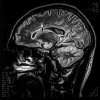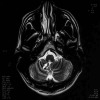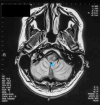A Case Report on Multiple Sclerosis Associated With Atrial Fibrillation and Neurogenic Hypertension: Area Postrema Syndrome?
- PMID: 38595879
- PMCID: PMC11002330
- DOI: 10.7759/cureus.55860
A Case Report on Multiple Sclerosis Associated With Atrial Fibrillation and Neurogenic Hypertension: Area Postrema Syndrome?
Abstract
Multiple sclerosis (MS) is an autoimmune demyelinating neurological disorder primarily manifesting with a range of neurological symptoms, with cardiovascular autonomic involvement being a rare occurrence. We report a case where a patient initially presented with Bell's palsy, without other notable symptoms or signs, and subsequently developed atrial fibrillation, hypertension, and hemiparesis. Magnetic resonance imaging (MRI) revealed extensive demyelination in the cerebral hemispheres, brainstem, and notably, the area postrema. The anatomy of the area postrema and its connections, in relation to neurogenic hypertension, are discussed. The demyelination in the area postrema was thought to be the cause of our patient's arrhythmias and acute hypertension. Furthermore, we discuss the cerebral origins of cardiac arrhythmias, with a focus on MS and other neurological conditions. This case underscores the rarity of isolated cranial neuropathies, such as Bell's palsy, as an initial sign of MS, marking the onset of a relapse.
Keywords: area postrema (ap); atrial fibrillation; bell's palsy; multiple sclerosis; neurogenic hypertension.
Copyright © 2024, Prentice et al.
Conflict of interest statement
The authors have declared that no competing interests exist.
Figures



Similar articles
-
Seropositive Neuromyelitis Optica in a Case of Undiagnosed Ankylosing Spondylitis: A Neuro-Rheumatological Conundrum.Qatar Med J. 2022 Jul 7;2022(3):29. doi: 10.5339/qmj.2022.29. eCollection 2022. Qatar Med J. 2022. PMID: 35864917 Free PMC article.
-
The Vital Role of Clinical Examination in Unmasking Bell's Palsy: Beyond Pattern Recognition.Cureus. 2024 Mar 1;16(3):e55311. doi: 10.7759/cureus.55311. eCollection 2024 Mar. Cureus. 2024. PMID: 38559504 Free PMC article.
-
Bell's palsy after inactivated COVID-19 vaccination in a patient with history of recurrent Bell's palsy: A case report.World J Clin Cases. 2021 Sep 26;9(27):8274-8279. doi: 10.12998/wjcc.v9.i27.8274. World J Clin Cases. 2021. PMID: 34621891 Free PMC article.
-
Bell's palsy with facial bone involvement: A rare presentation of chronic nonbacterial osteomyelitis with literature review.Mod Rheumatol Case Rep. 2023 Jan 3;7(1):298-301. doi: 10.1093/mrcr/rxac058. Mod Rheumatol Case Rep. 2023. PMID: 35876059 Review.
-
Facial palsy from temporal bone lesions.Ann Acad Med Singap. 2005 May;34(4):322-9. Ann Acad Med Singap. 2005. PMID: 15937573 Review.
References
Publication types
LinkOut - more resources
Full Text Sources
